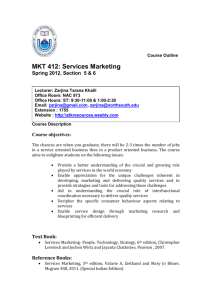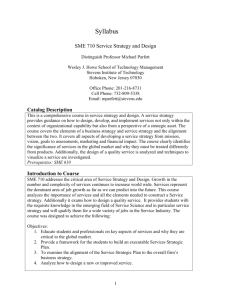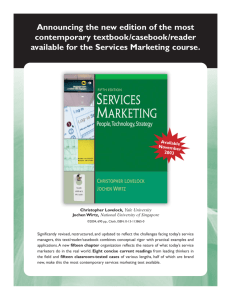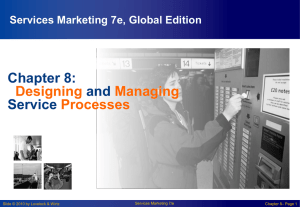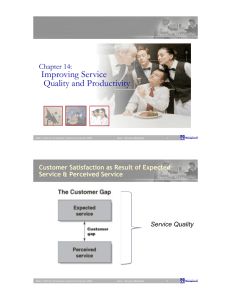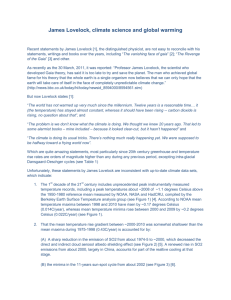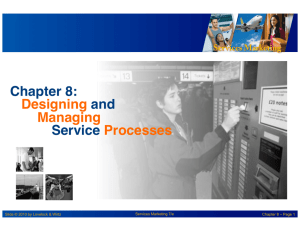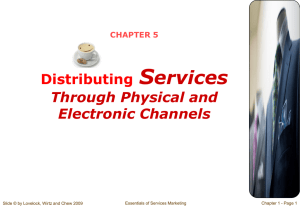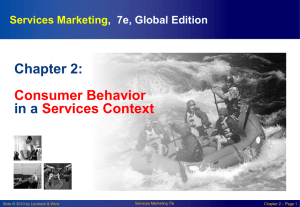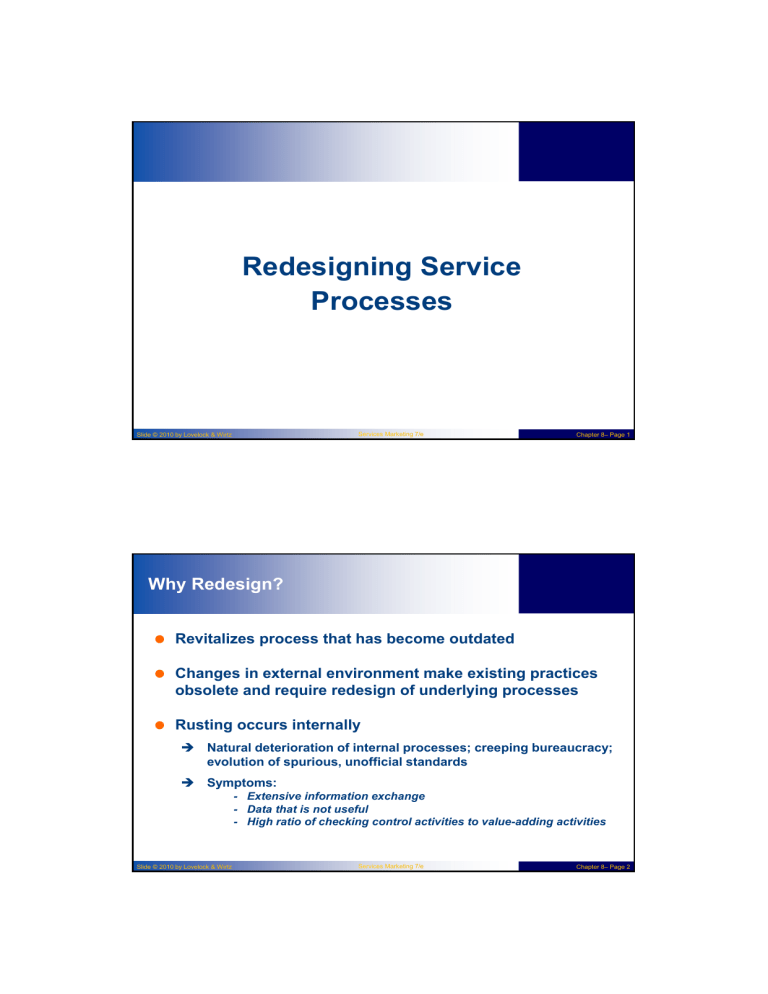
Redesigning Service Processes Services Marketing 7/e Slide © 2010 by Lovelock & Wirtz Chapter 8– Page 1 Why Redesign? Revitalizes process that has become outdated Changes in external environment make existing practices obsolete and require redesign of underlying processes Rusting occurs internally Natural deterioration of internal processes; creeping bureaucracy; evolution of spurious, unofficial standards Symptoms: - Extensive information exchange - Data that is not useful - High ratio of checking control activities to value-adding activities Slide © 2010 by Lovelock & Wirtz Services Marketing 7/e Chapter 8– Page 2 Why Redesign? “Institutions are like steel beams—they tend to rust. What was once smooth and shiny and nice tends to become rusty.” Mitchell T. Rabkin, MD, former president of Boston’s Beth Israel Hospital Slide © 2010 by Lovelock & Wirtz Services Marketing 7/e Chapter 8– Page 3 Why Redesign? Redesign aims to achieve these performance measures: Reduced number of service failures Reduced cycle time from customer initiation of a service process to its completion Enhanced productivity Increased customer satisfaction Slide © 2010 by Lovelock & Wirtz Services Marketing 7/e Chapter 8– Page 4 Process Redesign: Approaches and Potential Benefits Eliminating nonvalue-adding steps Shifting to selfservice Delivering direct service Slide © 2010 by Lovelock & Wirtz • Streamline front-end and back-end processes of services • Improve productivity and customer satisfaction • • • • Increase in productivity and service quality Lower costs and perhaps prices Enhance technology reputation Differentiates company • Improve convenience for customers • Productivity can be improved by eliminating expensive retail locations • Increase customer base Services Marketing 7/e Chapter 8– Page 5 Process Redesign: Approaches and Potential Benefits Bundling services Redesigning physical aspects of service process Slide © 2010 by Lovelock & Wirtz • Involves grouping multiple services into one offer, focusing on a well-defined customer group • A better fit to the needs of target segment • Increase productivity with customized service • Increase per capita service use • Focus on tangible elements of service process (facilities and equipment) • Increase convenience • Enhance satisfaction and productivity of frontline staff • Cultivate interest in customers Services Marketing 7/e Chapter 8– Page 6 The Customer as Co-Producer Services Marketing 7/e Slide © 2010 by Lovelock & Wirtz Chapter 8– Page 7 Levels of Customer Participation High – Customer works actively with provider to co-produce the service • Service cannot be created without customer’s active participation • Customer can jeopardize quality of service outcome Medium – Customer inputs required to assist provider • Provide needed information and instructions • Make some personal effort; share physical possessions Low – Employees and systems do all the work • Involves standardized work Slide © 2010 by Lovelock & Wirtz Services Marketing 7/e Chapter 8– Page 8 Customers as Partial Employees Customers can influence productivity and quality of service processes and outputs Customers not only bring expectations and needs but also need to have relevant service production competencies For the relationship to last, both parties need to cooperate with each other Slide © 2010 by Lovelock & Wirtz Services Marketing 7/e Chapter 8– Page 9 Managing Customers Recruitment and Selection Job Analysis Education and Training • Recruit customers that possess the competency to perform the necessary tasks • Are customers aware of their roles and equipped with the required skills? • Information required for them to perform their roles via instructions or video demonstration Motivate • Ensure that they will be rewarded for good performance Appraise • For sub-par performances, improve customer training or change the role or process Ending Slide © 2010 by Lovelock & Wirtz • Last resort: if customer is non compliant consider termination of the relationship Services Marketing 7/e Chapter 8– Page 10 Self-Service Technologies Slide © 2010 by Lovelock & Wirtz Services Marketing 7/e Chapter 8– Page 11 Self-Service Technologies (SSTs) SSTs are the ultimate form of customer involvement where customers undertake specific activities using facilities or systems provided by service supplier Customer’s time and effort replace those of employees Information-based services lend selves particularly well to SSTs Used in both supplementary services and delivery of core product Slide © 2010 by Lovelock & Wirtz Services Marketing 7/e Chapter 8– Page 12 Self-Service Technologies (SSTs) Many companies and government organizations seek to divert customers from employee contact to Internet-based selfservice Advantages: Disadvantages: Time and Cost savings Flexibility Convenience of location Greater control over service delivery High perceived level of customization Slide © 2010 by Lovelock & Wirtz Anxiety and stress experienced by customers who are uncomfortable with using them Some see service encounters as social experiences and prefer to deal with people Services Marketing 7/e Chapter 8– Page 13 What Aspects Of SSTs Please Or Annoy Customers? People love SSTs when… People hate SSTs when… • SST machines are conveniently located and accessible 24/7– often as close as the nearest computer! • SSTs fail – system is down, PIN numbers not accepted, etc. •Obtaining detailed information and completing transactions can be done faster than through face-to-face or telephone contact • Customers themselves mess up– forgetting passwords; failing to provide information as requested; simply hitting wrong buttons Key weakness:Few firms incorporate service recovery systems such that customers are still forced to make telephone calls or personal visits Slide © 2010 by Lovelock & Wirtz Services Marketing 7/e Chapter 8– Page 14 Putting SSTs to Test by Asking a Few Simple Questions Does the SST work reliably? Firms must ensure that SSTs are dependable and user-friendly Is the SST better than interpersonal alternatives? Customers will stick to conventional methods if SST doesn’t create benefits for them If it fails, what systems are in place to recover? Always provide systems, structures, and technologies that will enable prompt service recovery when things fail Slide © 2010 by Lovelock & Wirtz Services Marketing 7/e Chapter 8– Page 15 Managing Customer’s Reluctance to Change Increasing customer’s participation level in a service can be difficult Marketing communications to be used to: Prepare customer for change Explain the rationale and benefits What customers need to do differently in the future Slide © 2010 by Lovelock & Wirtz Services Marketing 7/e Chapter 8– Page 16
